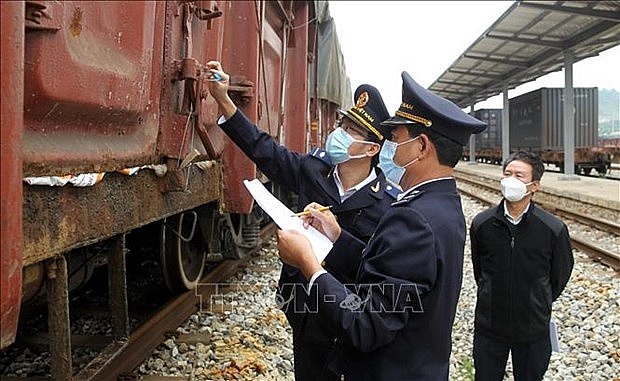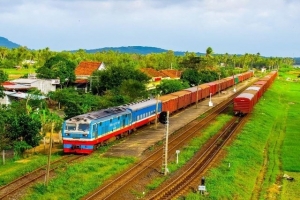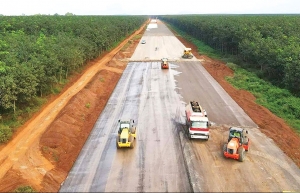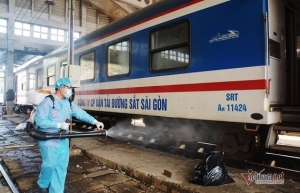Railway overhaul front and centre for national corporation
The first international freight train departing from Kep Station in the northern province of Bac Giang to China was officially launched at the end of February. Commenting on the milestone, Dang Sy Manh, general director of Vietnam Railway Corporation (VNR), said, “Although the scale of capital is not large, this is the first concrete step of VNR in implementing the plan to improve international intermodal freight by rail.”
 |
| Illustrative image (Source: VNA) |
Transforming Kep Station into an international intermodal terminal not only helps relieve the congestion of goods but will also reduce customs clearance times at the border and at two international intermodal terminals in operation, Yen Vien and Dong Dang.
It also helps VNR secure stronger footholds in many industrial parks (IPs) after the initial success of the rail container transport route from Vietnam to Europe.
VNR has changed its focus in recent times from passenger travel to freight transport. The switch was presented in the VNR Restructuring Project for 2021-2025, which is being reviewed by different ministries before being submitted for government approval.
This shift will help VNR compensate for the sharp decrease in passenger transport volume due to competition with road transport and low-cost airlines, and reflects efforts to avoid stagnation.
In February, the Politburo issued Conclusion No. 49-KL/TW on the development of Vietnam’s railway transport for the rest of this decade. The conclusion noted confidence in VNR to innovate its business and corporate governance, something that VNR has made efforts to boost for many years already.
The company is promoting the transportation of cargo by passenger trains, while also serving tenants in IPs and organising a wider sale of e-tickets on websites. Other solutions have included expanding the ticket sales model with associated partners, as well as restructuring businesses according to the lean approach.
However, the company has also experienced some turbulence over the years, such as the collapse of Vietnam’s main railway link between the north and the south, Ghenh Bridge, in 2016, and the pandemic-era restrictions. Most of VNR’s innovative projects were delayed as a result, and some projects have not yet received approval.
The VNR Restructuring Project was first proposed in 2015 to reorganise and divest capital from enterprises under the corporation. The aim was for a more reasonable production and business organisation model covering railroad transport, infrastructure, and mechanics.
“We were at a dead-end. If we did nothing to help inefficient businesses, the brand would not be able to exist in a few years. Although railroading is a traditional profession, we need to make reforms and cut unreasonable costs to bring the railroad segment back on track soon,” general director Manh stated.
However, no version of the initiative has ever been approved for various reasons. The timeline of the project shifted from the 2017-2020 period to 2021-2025 and, due to the delays, VNR leaders said it missed out on many business opportunities.
Another issue is that most railway assets are owned by the state. Thus, it is hard for VNR to make investment decisions, especially when upgrading railroad stations and warehouses.
“VNR looks big, but the company only has one train as a corporate asset. All infrastructure assets, from railroads to railroad stations and warehouses, belong to the state. We have to ask permission for everything we do, even fixing a restroom at a station,” one VNR leader said
Railway maintenance expenses are taken from the state budget of VND3 trillion ($127.9 million) per year. After deducting expenses for maintenance of mainline infrastructure, units can only receive VND20-30 billion ($853,000-1.27 million) for the renovation of stations and cargo yards. As a result, the majority of stations and logistics warehouses on the national railway system are degrading and becoming obsolete on a huge scale, leaving customers and passengers frustrated.
Currently, VNR is still persistently proposing that competent authorities develop a project on the management and use of national railway infrastructure assets invested by the state according to Decree No.46/2018/ND-CP in the direction of piloting 15 terminal stations for goods and passengers through state capital investment in enterprises.
“VNR will prioritise the selection of freight stations, international connections, seaports, and some passenger stations in major city centres. If we are assigned to manage it, we will be able to mobilise capital to upgrade the stations with our own capital or mobilise it from all resources,” the VNR leader said.
 | Boosting international railway transport investment The initial successes of the railway container transport network from Vietnam to Europe have provided a fulcrum inspiring the railway sector to increasingly engage with the international network. |
 | Vietnam’s transport sector seeking recovery and reboot While making good recovery during 2022, Vietnam’s transport sector is betting on new policies and plans to increase private investment to obtain its ambitious goals. |
 | National railway investment requiring foreign push Foreign investors are being urged to explore funding railway lines linking seaports as part of the country’s railway development plan – despite high costs, few successful projects, and a lengthy period to see returns. |
What the stars mean:
★ Poor ★ ★ Promising ★★★ Good ★★★★ Very good ★★★★★ Exceptional
Related Contents
Latest News
More News
- Global partnerships key to Vietnam’s IFC development (December 26, 2025 | 16:18)
- Vingroup pulls out of bid to invest in North-South high-speed railway (December 26, 2025 | 11:42)
- Strengthening supply chains through trade promotions and customs reform (December 24, 2025 | 14:00)
- PM orders investment model for North–South high-speed rail (December 22, 2025 | 17:43)
- LS Eco Energy to invest in Vietnam rare earth sector (December 22, 2025 | 17:31)
- Government moves to establish International Financial Centre (December 21, 2025 | 21:00)
- Vietnam's IFC to target global investment flows (December 21, 2025 | 18:00)
- Two national hospitals expand capacity with new facilities (December 20, 2025 | 09:00)
- Ha Tinh breaks ground on major Vingroup industrial and energy projects (December 19, 2025 | 18:24)
- EVN launches major power infrastructure projects nationwide (December 19, 2025 | 18:17)

 Tag:
Tag:





















 Mobile Version
Mobile Version